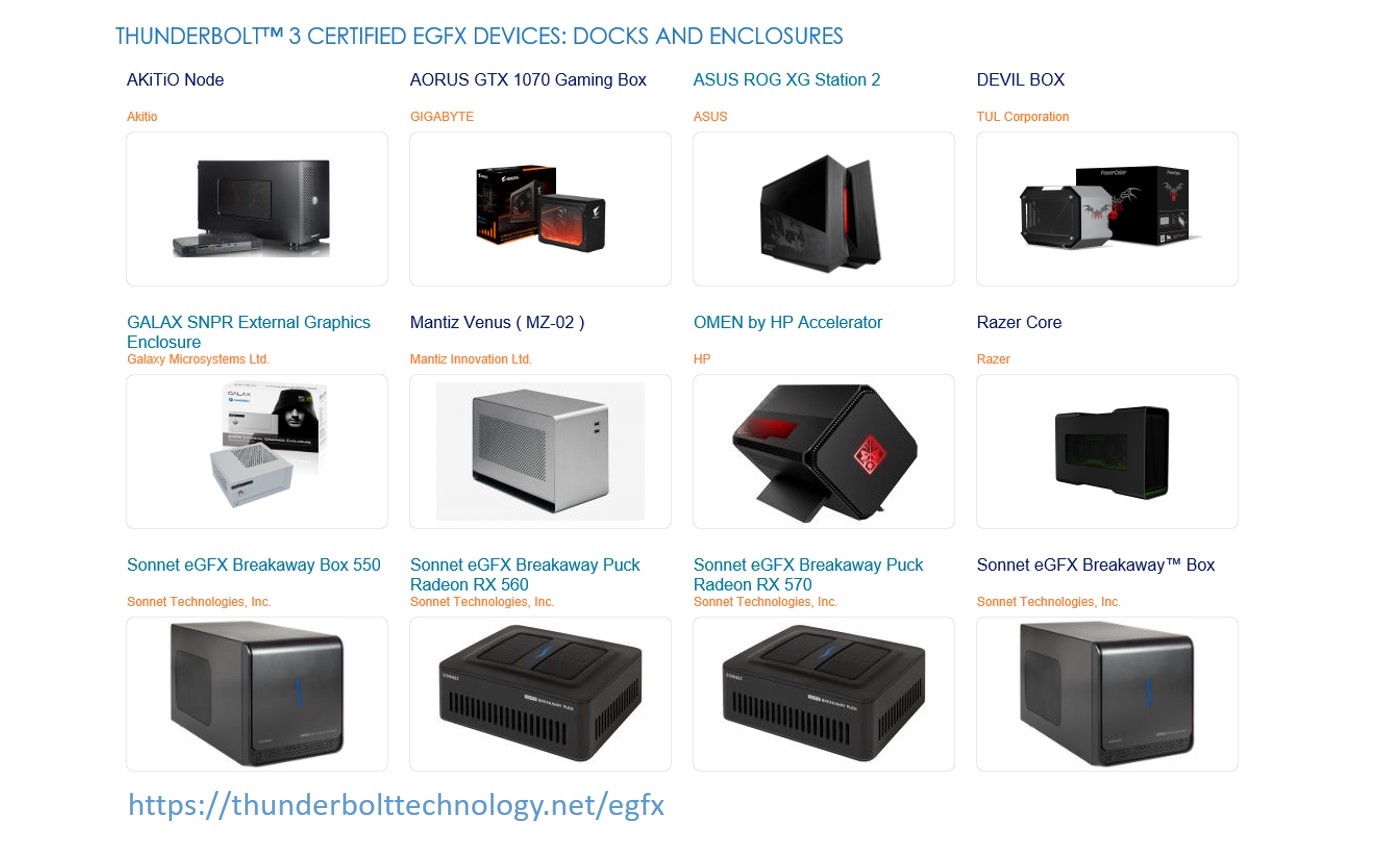Ravi Gananathan, Thunderbolt™ 3 eGFX Marketing
Thunderbolt™ 3 brings to notebook PCs the ability to dramatically expand functionality with a simple plug-and-play connection to a Thunderbolt 3 external graphics (eGFX) or a PCIe expansion device.
Typical non-Thunderbolt 3 notebook systems have limited ability to expand system functionality. Thunderbolt 3 enabled notebook systems provide users a wider choice to expand functionality including some very surprising advanced capabilities to boost graphics performance, by using an eGFX solution for gaming and professional or commercial applications.
Big Picture – Expanding PC capabilities with Thunderbolt-3 Enclosures
Thunderbolt 3 enclosures have two product categories:
- Thunderbolt 3 eGFX enclosures that are specifically designed and certified for use with industry-leading graphics cards, and
- Thunderbolt 3 generic PCIe expansion chassis that are certified for use with generic PCIe cards for various other non-graphics applications.
This distinction may be confusing for users new to Thunderbolt 3. Here, we take a moment to help explain the differences between eGFX and PCIe expansion devices, as well as the rational for various design choices, so that you can make more informed decisions on a solution best-suited for your applications.
Thunderbolt 3 PCIe Generic Expansion Chassis
A generic Thunderbolt 3 PCIe expansion chassis is a general purpose device. They typically have two Thunderbolt 3 ports for supporting up to five additional Thunderbolt devices in a daisy chain configuration. Additionally, they may have more than one PCIe slot supporting multiple PCIe cards for use with applications such as network expansion, audio capture and storage cards.
As many users know, these types of expansion devices have been around for many years and do-it-yourself (DIY) enthusiasts have hacked configurations to work with graphics (GPU) cards. While these generic enclosures may work with GPU cards, they typically come with lower wattage power supplies, and on some designs, the PCIe bridges used introduce additional latencies that may affect GPU performance. For these reasons, such generic PCIe enclosures are not validated as part of the Thunderbolt certification process for eGFX usage.
Thunderbolt 3 eGFX Enclosure
In contrast, an eGFX enclosure is a dedicated device for graphic applications. It is specifically designed for use with high-performance graphics cards. Power supplies are properly selected to support the peak current demands of the selected graphics cards and the eGFX enclosures are tested for thermal and electrical characteristics to ensure that the graphics cards selected by the manufacturer will not throttle or shut down under heavy graphics use. This means that not all graphics enclosures, even if they are physically large, may not support all graphics cards. So, be sure to consult your enclosure manufacturer’s selected/qualified graphics card list to ensure your preferred graphics card is supported.
The designs are also typically verified for plug-and-play eGFX support under Windows* 10 operating system with compatible PC systems. As part of the certification requirement, Thunderbolt 3 certified eGFX vendors are required to maintain a list of compatible PC systems along with a list of graphics cards they qualify as compatible for the given enclosure’s thermal and power design. For maximum confidence, always check www.ThunderboltTechnology.net/egfx to ensure the device you are considering is a certified Thunderbolt 3 eGFX enclosure (beware of uncertified products being promoted for eGFX usage).
To ensure consistent performance and user experience for graphics applications, Thunderbolt 3 eGFX enclosures have a few controlled configuration requirements. At this time, eGFX enclosure designs are restricted to only one Thunderbolt 3 port (i.e., daisy chaining with other Thunderbolt devices is not supported) and only one PCIe slot (i.e., only one GPU card is supported). All other necessary peripheral devices must directly connect to the host PC system or to the eGFX enclosure if additional I/O ports are available on the eGFX enclosure.
Please refer to your eGFX enclosure manufacturer for detailed configuration and support information. Again, these guidelines are intended to deliver a better overall user experience, since daisy chaining and additional PCIe bridges/ports can impact some GPU applications and may not consistently deliver the best user experience. Note also that multiple GPUs cannot be supported in the eGFX configuration under Windows 10 at this time.
Conclusion/Recommendation
External graphics is a complex and demanding use case requiring many components – Thunderbolt 3, OS, System BIOS and GPU drivers – to work together to ensure a seamless plug-and-play experience. We are making every effort to work with the various ecosystem companies to continually improve and ensure your eGFX user experience is as smooth as possible. Although eGFX features are still evolving, the Thunderbolt 3 certification process, along with specific eGFX requirements for PCs and external eGFX devices, is designed to enable the development of a reliable, convenient, interoperable and simple-to-use ecosystem for external graphics.
Here are a few quick reminders:
- Today, Thunderbolt 3 eGFX devices are certified for Windows 10 systems only. Not all eGFX enclosures support ALL graphics cards. Check with your device vendor to ensure your PC system and your graphics card are recommended for use with their eGFX device.
- Beware of uncertified products with Thunderbolt interface being promoted for eGFX usage. Always check products on https://thunderbolttechnology.net/egfx to ensure that the device you are considering is a Thunderbolt 3 certified eGFX device.
- As outlined above, Thunderbolt 3 certified generic PCIe expansion enclosures are not meant for eGFX usage and vendors of such enclosures are not allowed to market them for graphics use. It is recommended that you avoid using these enclosures with graphics cards.

Intel, the Intel logo, Thunderbolt, and the Thunderbolt logo are trademarks of Intel Corporation in the U.S. and/or other countries.
*Other names and brands may be claimed as the property of others.


Follow Intel & Learn More About Thunderbolt™ Subscribe to Intel's YouTube Channel